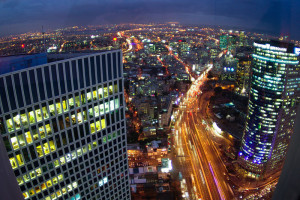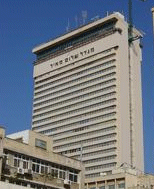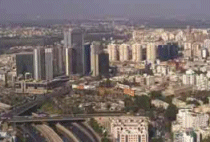Tel Aviv, the second largest city in Israel, was established in July 1906 when a group of Jews, among them residents of Jaffa, followed the initiative of Akiva Arye Weiss and together formed the Ahuzat Bayit (“homestead”) society. Their goal was to form a “Hebrew urban center in a healthy environment, planned according to the rules of aesthetics and modern hygiene.” The city planning was influenced by the Garden City movement.
The first 60 plots were purchased in Kerem Djebali near Jaffa by Jacobus Kann, a Dutch citizen, who registered them in his name to circumvent the Turkish prohibition on Jewish land ownership. One of the most notable members of the group was Meir Dizengoff, who later became the first mayor of the city. His vision for Tel Aviv involved a grand city with peaceful co-existence for all the residents.
By the start of the First World War in 1914, Tel Aviv had grown to more than 1 square kilometre (247 acres). The growth stopped abruptly in 1917, when the Ottoman Empire expelled all the Jews from Tel Aviv and Jaffa. Following the defeat of the Ottomans at the end of the war, the Jews were free to return to their homes in Tel Aviv.
In Hebrew, “tel” means a mound of ancient ruins and “aviv” means spring. A few months after Tel Aviv was founded, her first children were born: Aharon Denin, the son of Yehezkel Sokovolsky Denin, and Ahuzabet Weiss, daughter of Akiva Arieh Weiss.
Weiss had been instrumental in the establishment of Ahuzat Bait, Tel Aviv’s first neighborhood. He wanted to name his daughter Ahuzat Bait, thus formalizing the link between the two historic events, the birth of the first Hebrew city and the birth of his daughter. His wife objected.
In the end, the parents compromised on Ahuzabet (similar to Elizabeth).
There are scores of parks, gardens, and green areas all over the city-Edith Wolfson Park in East Tel Aviv, Davidoff Park in Yafo, Charles Clore Park near the beach, and Gan Ha’ir Park near city hall. The municipality has recently approved the full plan for Menachem Begin Park in the south.
Great Tourist Attractions:
- SHALOM TOWER OBSERVATORY
9 Achad Ha’am St., Tel Aviv. Tel. 03-517-7304.
Open: Sunday-Thursday: 10:00-18:30, Friday: 10:00-14:00, Saturday: 11:00-16:00. - AZRIELI OBSERVATORY
www.azrielicenter.co.il
Azrieli Center (Round Tower, 49th Floor), 132 Menachem Begin Rd., Tel Aviv.
Tel. 03-608-1179. Closed on Monday. - Old Jaffa
- Yehoshua Gardens – Hayarkon Park
- Carmel Market – Shuk haCarmel
- Bauhaus Architecture
All over the city
Bauhaus architecture was introduced to Tel Aviv in the 1920s and 20s by German Jewish architects who settled in Palestine after the rise of the Nazis. The area in Tel Aviv known as the “White City”, around the city center contains almost 5500 examples of the modernist style known as Bauhaus. Construction of these buildings continued until the 1950s in the area around Rothschild Boulevard. Some 3000 buildings were constructed in this style between the years 1931 to 39. In the 1960s, this architectural style gave way to office towers and a chain of waterfront hotels and commercial skyscrapers. Some of Tel Aviv’s Modernist buildings were neglected to the point of ruin. Before legislation to preserve this landmark architecture, many of the old buildings were demolished. Efforts are under way to refurbish Bauhaus buildings and restore them to their original condition. Thes buildings are now protected landmarks, and are collectively a UNESCO World Heritage Site.
There is a small museum dedicated to the Bauhaus style in Tel Aviv on Bialik street, near the old City Hall.
Great Tel Aviv Links:
- Tel Aviv Municipality
- Eretz Israel Museum
- Tel Aviv Museum of Art
- Jewish Diaspora Museum
- Ben Gurion Museum
- Eretz Israel Museum
- Jabotinsky Institute
- Habima
- The Cameri
- Tel Aviv Insider
Popular Beaches
- Tel Baruch Beach
- Metzitzim Beach
- Hof Hadatiyim
- Hof Haclavim
- Hof Hilton
- Gordon-Frishman beach
- Hof Yerushlaim
- Banana Beach
- Hof HaDolphinarium
- Alma Beach



